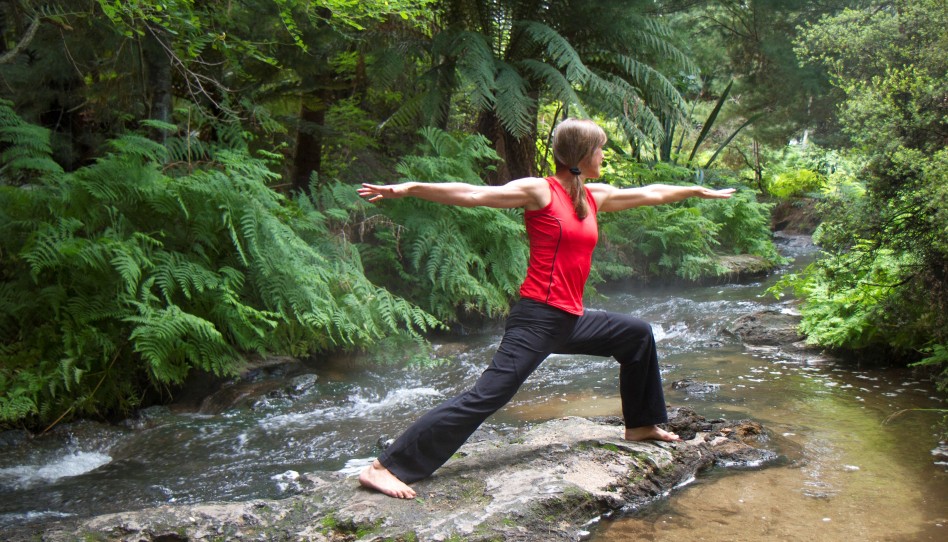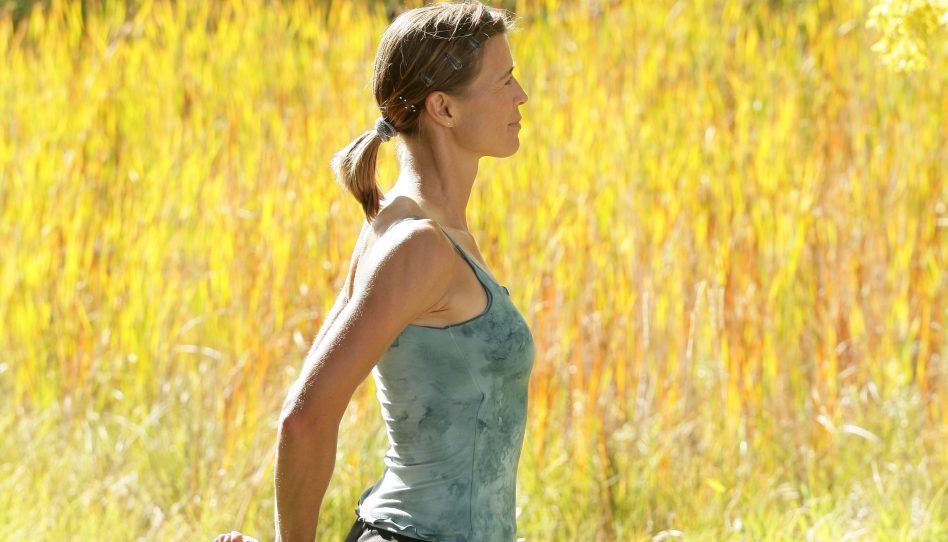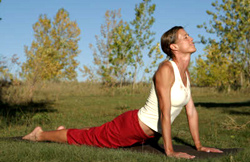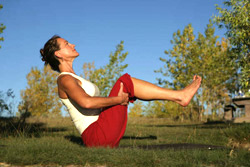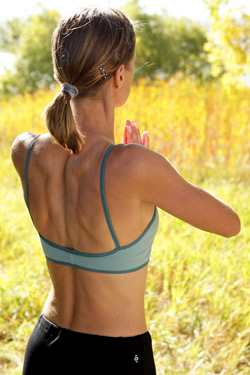Yoga for Performancesm: Runners’ Sequence, Part 2
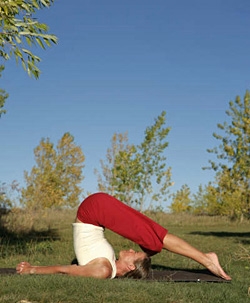
Welcome back! Last month, in Part 1 of the yoga sequence for runners, we explained some of the strengthening, heat-producing standing poses of our yoga routine. Today, in Part 2, we will continue the core work of the practice with sitting poses. These are less strength-based, but require complete focus to execute correctly and with proper body alignment. This group of postures is designed to achieve the optimal benefits of muscle lengthening and enhancement.
Compared with standing poses, sitting poses have more of a calming effect on the body and mind, so they are particularly well-suited to be practiced towards the end of the routine. Besides the “cooling down” effect, the specific postures called “head beyond the knee” and “seated forward bend” also help to stretch hamstrings and the lower back muscles. Following those with the “plough pose” will simultaneously restore your energy and generate a calming effect.
Approach the poses in a balanced way. A healthy practice requires a balance between self-effort and surrender. This means taking a pose far enough to challenge your muscles, but never to a point of unhealthy strain or discomfort. Take your time and allow your body to adapt to each pose.
As always, your yoga practice should end with at least five minutes in savasana (corpse pose). Rest, starting with a few deep inhalations and exhalations, then allow your breath to be natural. Enjoy the calmness and stillness of your body. Wind down and savor the satisfying feeling of having completed another yoga session.
Poses: Runners’ Sequence (Part 2)
Boat Pose — Navasana
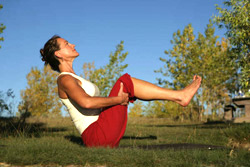
Benefits:
- “Nava” means boat or vessel. Steady practice of this pose will allow your body or “vessel” to weather any storm. This is a great pose to tone and strengthen the abdominal muscles and organs as well as the hip flexors.
- The muscles of the lower back are evenly developed with regular practice and better sitting posture is achieved.
How to:
- Sit on your mat with your hands alongside the hips. Your legs should be straight out in front of you. Inhale and lift your chest.
- Exhale as you lean your body back slightly and raise your legs. Bend your knees so your calves are parallel to the floor. Grab the back of your thighs just below the knees and gently hold your legs in this position.
- Inhale as you lift the chest and heart forward and draw in the lower back so it is slightly concave.
- Hold the pose for several breaths, keeping the chest open and the shoulders rolled back. To come out of the pose, gently release your legs and hands back to the floor.
Extended Boat Pose — Paripurna Navasana
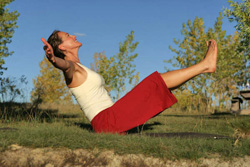
Benefits:
- “Paripurna” means complete or whole. This version of the full boat pose works on the body’s core on a deeper level than the previous variation.
How to:
- From Step 3 above, exhale as you straighten the legs and open the arms out wide to the sides. Lean back as far as you can without falling back. Continue to open the chest up and forward. Look up and hold for several breaths before carefully releasing the legs and your hands to the floor.
Bridge Pose — Setu Bandhasana
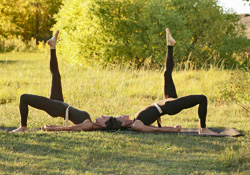
Benefits:
- Bridge Pose supports the nervous system. It is a gentle backbend that opens and strengthens the chest, strengthens the muscles between the shoulder blades, and increases the flexibility of the shoulders, wrists and upper back.
- This is a wonderful exercise for people who sit for long periods. Because Bridge Pose opens up the front of the body, and strengthens the hamstrings, gluteus muscles as well as the lumbar spine and hips, it also is effective in improving poor posture.
How to:
- Lie flat on your back and bend your knees so that you can just touch your heels with your fingertips. The feet are close to your buttocks and flat on the floor. Have the arms close to your body, palms facing down.
- As you inhale, push down with your hands and lift your hips off the floor until your body is linear. Lengthen your pelvis out and away so that you are pushing your pelvis away from your chest and the chest away from your pelvis. Keep the thighs pointing straight ahead.
- Bring your hands together, interlocking the fingers, and press the little fingers to the floor. This will help to lift the pelvis even higher. To get the full benefit of the exercise, roll up on top of your shoulders, protecting the spine by rolling the shoulders under-first one side, then the other. Your arms will act as support. Remain in this position for five to ten breaths.
- For a more advanced version (see photo): In One Legged Bridge Pose, bring your feet close together, lean slightly towards one leg, press the foot on this side into the floor and with an inhalation, lift the other leg up, straightening until it is perpendicular to the floor with the foot and toes pointed towards the sky. Continue to engage the glutes as you lift the leg higher. Remain in this position for five to ten breaths, focusing on lifting the pelvis up and keeping the body long. To release, slowly bring the extended leg back to the original position and repeat on the other side.
Supported Hero Pose — Supta Virasana
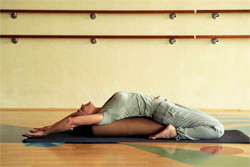
Benefits:
- “Vira” means hero, and your quads will attest to this. Vira provides a wonderful stretch for the thighs, knees and ankles, while promoting flexibility in the lower back
- Although this pose can be very beneficial to those with knee issues, if you do have knee pain or an injury, practice this only in the presence of an experienced yoga teacher.
How to:
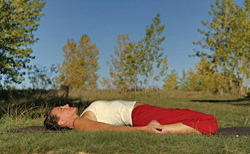 Supported Hero Pose without bolster © Tim DeFrisco
Supported Hero Pose without bolster © Tim DeFriscoStart on all fours. Bring the knees together and the tops of your feet to the floor. Arrange a bolster behind you on the mat. Slowly sit down on one end of the bolster, which is placed between your feet. The toes point straight back. Check that the ankles don’t “sickle” or curve inwards. The knees are as close together as possible and the thighs are parallel
- Inhale and allow the spine to lengthen up, the chest to expand and the shoulders to softly roll back.
- Exhale as you gently walk your hands behind you. Continue to slowly lower yourself back onto the bolster (as your knees, ankles and quads allow). If you are able to lower all the way down so your entire back is resting along the bolster, let the head rest as well. Bring the arms overhead, if you would like.
- Stay here, breathing steadily, at least one minute. To come out of the pose, inhale, then exhale as you slowly walk the hands forward until you are sitting upright.
For a more advanced version (see photo 2): Because this version is done without a bolster, the stretch to the quads, knees, ankles and back will be deeper. Follow the above instructions to get in and out of the pose.
Cobbler’s Pose (with partner) — Baddha Konasana
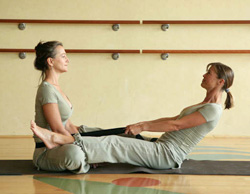
Benefits:
- A great pose to lengthen the adductors (the muscles of the inner thighs) and relax the abdomen.
- Fantastic for the tight hips runners are known for!
How to:
- From a sitting position on your mat, bring the soles of the feet together. Draw your heels in towards you. Open the knees outward towards the floor while you lengthen up the spine. Take hold of the feet from the outside and open them like the leaves of a book. Keep the spine long, the chest open and the shoulders open.
- If using a partner, have her wrap a strap around your lower back and take hold of both ends of the strap. Your partner will gently place her ankles on your thighs, close to the torso. She’ll take a firm hold of the straps and pull back to help you maintain a slight inward curve of the lower back and a straight spine. This may be enough of a stretch for you.
- To increase the stretch, your partner can press down with her ankles on your thighs and slowly roll out along the thighs, pressing your knees closer to the floor. Hold for about one minute, breathing steadily, then release.
- Communicate with your partner about the depth of the stretch-it’s important that you’re not feeling overstretched, or the muscles won’t relax.
Head Beyond the Knee Pose — Janu Sirsasana
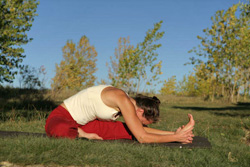
Benefits:
- Janu Sirsasana has a calming effect on the mind, and tones the spleen, kidney and liver. It may also help to lower blood pressure.
- This is a great stretch for the hamstrings and lower back muscles. Move gently into this pose and don’t try to overstretch; it is okay to bend your knee slightly if you feel discomfort.
How to:
- I often find with athletes who have particularly tight hamstrings that the initial sitting position of this asana already provides some significant stretching benefits. Don’t be discouraged if you feel a stretch simply sitting up or with a slight forward bend as you reach your hands towards your left knee.
- Sit on your mat with the legs together straight out in front of you. Bend your right leg, placing the sole of the right foot up against your left inner thigh. Keep your hips square. Inhale and raise your arms up and over your head towards the ceiling. Rotate from the lower belly turning the torso to the left as you maintain a lengthened spine.
- Exhale as you fold the upper body forward and down. Grasp your left foot or the leg, as far down as possible, keeping the left leg engaged with toes pointing up. The pelvis should remain square and slightly rotated forward.
- Tilt the pelvis forward as much as you can and continue to lengthen the spine, rather than rounding the back as you reach forward. Stay in this position for several breaths. Repeat on the other side.
Seated Forward Bend (with partner) — Paschimottanasana
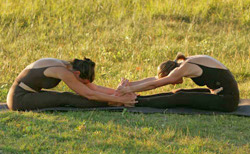
Benefits:
- The hamstrings are given a wonderful stretch in this pose. It also gives an intense stretch to the back of the body as it folds forward.
- Traditionally, forward bends are introspective and create space for a quiet re-connection with ourselves. Because the heart is higher than the head, this is a pose where the heart rules over our thinking mind.
How to:
- From a sitting position tilt the weight forward onto the front edge of the sitting bones. Try to maintain a slight inward curve of the lower back. Inhale as you lift the arms overhead, stretching the torso up away from the grounded sitting bones.
- On an exhale, keep the spine long as you reach forward towards your feet or shins, taking hold where you can. If using a partner, stretch forward to reach her ankles as she reaches forward to hold yours.
- Inhale, look forward, lift the chest and relax the stretch a bit. Exhale as you bend forward and take the pose deeper. Continue with this pulsation, at least ten breaths.
- To release, inhale as you slowly come up.
Plough Pose — Halasana

Benefits:
- Plough Pose is wonderfully rejuvenating for the entire nervous system. It increases blood flow and circulation, and has a toning and stimulating effect to the abdominal organs. Our athletes and clients love to practice this at the end of their yoga routine because it is a great pose to reduce fatigue.
- This is an excellent stretch for your spine, encouraging space to open between the vertebra. Halasana also releases tension in the neck and shoulders, and relaxes the muscles of the thighs.
How to:
- Lie on your back with your arms at your sides, palms facing down. Inhale, then with your next exhalation, slowly raise your knees towards your chest and continue to raise your legs and hips, rolling up over your head as far as you can, or until your toes touch the floor behind your head. Tuck the toes under.
- Roll the shoulders back, which brings the shoulder blades closer together. This protects and keeps pressure off the cervical spine. Place the hands to the middle of the back to stabilize it, then return your hands to the mat. If your feet don’t reach the floor, keep your hands on the back for support.
- Bring your hands together, interlock the fingers and roll farther onto the top of your shoulders. Take your time! A lot of weight is placed on your shoulders in this position. So, please be careful, and only exercise this position in the presence of an experienced yoga teacher! Press the little finger side of the hand against the floor and untuck your toes. Breathe equally and slowly, and rest in this position for at least ten breaths.
- To come out of the pose, release the clasped hands to your sides, palms down, and keeping the legs straight, slowly lower the buttocks towards the floor using your abdominals to control their descent. As you lower the legs, keep them close to your face as you unroll and keep the head on the floor.
Spinal Twist — Ardha Matsyendrasana
Benefits:
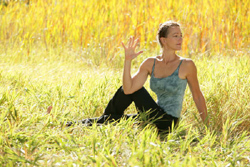
- Releases tension and increases flexibility in the neck, shoulders and spine.
- Improves lung capacity by stretching the intercostals (the muscles between the ribs) and opening the chest. It also gives a nice stretch to the glutes.
How to:
- Start in a sitting position with the legs straight ahead and hands on the floor behind you.
- Cross your left leg over your right leg and place your left foot flat on the floor beside your right knee. Bring your right elbow to the outside of the left knee and your left hand exactly behind the spine.
- Inhale deeply, then exhale slowly as you turn your shoulders as far as you can to the left, keeping the back straight and shoulders down with very little weight on your left hand. Envision the spine lengthening upwards.
- Breathe steadily, twisting a little more each time you exhale. Return to the position in Step 1, then repeat the sequence on the other side.
Get into Corpse Pose. Rest and relax…
Updated November 10, 2018
Updated May 12, 2014
Updated November 13, 2012
- Posted December 13, 2012
© Copyright 2006-2025 Uta Pippig and Take The Magic Step®. All Rights Reserved.
